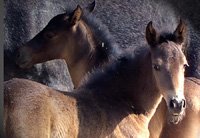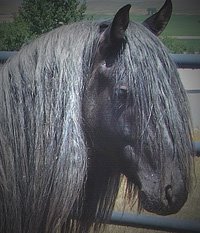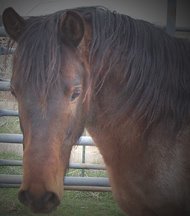My goodness! Is it the end of May already?
Between work travel and a disrupted internet connection, the weeks have slipped by since the Owyhee Spring endurance race that was Consolation's and my first of the year. A few of you have even sent emails wondering if our carcasses are rotting in the desert.
I'm happy to announce that Consolation and I survived the race in fine form, though it wasn't as smooth as I might have hoped. Since receiving our completion, I've mulled long and hard over the troubles we encountered and come to several, important conclusions that I think will improve our performance in future races.
But first, the story:
Owyhee Spring was a brand-new (and well-managed!) ride this year, held in southwestern Idaho's Owyhee canyonlands a mere 90 minute drive from In the Night Farm. We were, of course, hoping for sunny, brisk weather in keeping with the ride's name...but alas, the sky was leaden with windblown rainclouds as Ironman and I pulled into the desolate bit of ranchland that served as base camp.
We outfitted Consolation in a couple layers of blankets -- one for warmth and the other for waterproofing -- before heading off to the pre-ride meeting that was, blessedly, held in a large, fully-enclosed shop that contained quite an astonishing assortment of antiques, including a genuine Wells Fargo stagecoach in excellent repair. (I hear tell the owner may one day enlist his six matched, Amish-bred chestnuts to complete the hitch.)
After nightfall and a healthy splash of whiskey, I nestled in the back of Ironman's rig with fingers crossed that the next day's weather forecast, featuring heavy winds and thunderstorms, would prove wrong. That seemed unlikely, however, as I gradually drifted asleep to the rock of buffeting wind and spatters of rain on the roof.
It was a restless night, and morning came much later than I'd have liked. My alarm finally chimed at 5:30 a.m. I rolled over and listened for wind. None. Shivering and fumbling in the glow of a flashlight beam, I dressed in thermal socks and several layers of fleece before stepping out into the dark pre-dawn. Sure enough, the air was still, albiet scented of impending rain.
Consolation greeted me with a whicker that turned quickly to grouchiness when I distracted her from her breakfast long enough to slip Easyboot Gloves on her front hooves. I considered booting her hinds as well, but decided that her many miles of barefoot-on-gravel conditioning constituted adequate protection from the desert terrain.
By the time I mounted up for the 8:00 a.m. start -- about 20 minutes early because I wanted to ensure she was warmed up despite the chilly weather -- Consolation had clearly realized what we were there to do. The excitement of the event, plus over a week of rest prior to the race (not ideal, but my travel schedule didn't cooperate), had her feeling rather hotter than usual. This was not a bad thing. Consolation's "hot" equates to many endurance horses' "calm." Besides, I knew we'd need a bit of early speed in order to complete the ride at a decent hour.
We started off at a medium trot as soon as the trail opened, letting the field widen into a bubble around us as the front runners blazed ahead and the warming-ups and slow-steadies trailed behind. Consolation and I negotiated a pace that I felt would cover some ground and satisfy her need to move out, without allowing her to work above her present level of fitness, which wasn't as advanced as I'd have preferred.
The first loop led us 25 miles out across the desert, down into the canyon and along the Snake River, then back up a steep and rocky trail that slowed us to a walk for quite a distance. Although nearly everyone must have walked much of that ascent, it was afterward, as the trail stretched on, that riders began to pass as Consolation slowed to her customary 6-7 mph jog. I'd anticipated this and wasn't concerned, but I was mildly dismayed to find that Consolation expressed no interest in aligning herself with a passing group. It seemed she'd rather cover the miles at her comfortable pace than have the companionship of (let alone competition with) other horses.
And so, we arrived back at camp for the first vet check quite alone, but healthy and sound. I huddled in the car for a snack and some overdue efforts at hydration while Consolation, blanketed against a strong, damp wind that had risen with the sun, munched hay and beet pulp.

Forty minutes later, we started Loop 2 -- still wind-buffeted, still alone. We were only a few miles in when a lone rider paused in passing to ask about my saddle. I told her it was a Stonewall and the love of my life.
Her comment? "There's not much saddle there!"
"True," I agreed, "but it feels like more saddle than you'd think." Good thing, too -- because somewhere out on that 17-miles of trail, it became clear that I hadn't done as much riding as I ought to have to prepare myself for a 60. If you're going to ride tired, it's best to do it in a comfortable saddle!
Unfortunately, my beloved Stonewall couldn't help the fact that the kneepatch of my favorite breeches had, for reasons unknown, begun rubbing the back of my left knee. Discomfort turned to downright pain as Consolation and I trekked along through cheek-chafing wind and several cloudbursts. We were lucky, though -- ridecamp (and quite a few riders, too) suffered a heavy pounding of hail that afternoon.
More frustrating than the endless wind and my burning knee was Consolation's behavior. Early in the second loop, she began a campaign of resistance featuring sudden halts and refusals to resume forward movement. It was as though she was saying simply, "I'm done now. Not goin' on, sorry." Each time, getting her moving again required considerable urging.
I'd have been alarmed, of course, except that this tactic wasn't new. It was merely the latest in my strong-willed mare's experiments, exhibited during many, previous conditioning rides. She'd vetted through at the first check with all A's, was eating, drinking, peeing, and pooping normally, and generally gave me no particular cause for concern about her physical state.
Mentally, though, I had a battle on my hands. Consolation, fairly enough, didn't really see a point in continuing to cover ground, particularly out there in the storm-whipped desert, all alone, mile after desolate mile. She's too smart a horse to waste effort -- which, unfortunately for me and my rubbed knee, meant that I had to expend a great deal of effort indeed.
Pushing a testy mare through a 60 mile endurance ride is quite a different proposition than keeping her trotting for 15 miles of conditioning on a weekday afternoon. By the time we finished the third loop (with a ride time of 9:50, which would have been fine if I hadn't had to practically get off and shove my horse down the trail), I was considerably more exhausted than I've ever been after a ride of any distance.
The next day, despite having completed my longest ride to date, I was both sore and unsatisfied. Consolation's vet card showed all A's at the start and both mid-ride checks, and only a couple B's (impulsion and gait) at the finish. Despite a wickedly rainy, blustery night in camp following the ride, she presented the next morning bright-eyed and strong, with only a hint of stocking up around her fetlocks.
And yet...and yet. She hadn't been happy about those 60 miles. Her attitude and low energy level weren't anything I wanted to deal with at future rides. But what was I missing? Did she just need more experience, more time to go her own pace and discover the excitement of competition and speed? Could a subtle, physical issue underlie her reluctance?
After many days of thought and several conversations with other, more experienced endurance riders, I decided to apply a multi-pronged solution to our problem:
1. Higher-octane fuelThough Consolation has always maintained her weight easily on just a quality blend of grass hay and alfalfa, she may need additional energy from concentrated feed. Two weeks ago, I added a daily pound of beet pulp and 2.5 pounds of oats to her ration. Though minimal, this amount of grain, in addition to her usual hay, is all she seems able to consume in a day. Even so, it has certainly made a difference in her base energy level -- she's been considerably hotter (and a little faster) than usual on recent conditioning rides.
In the future, I may experiment with adding pure fat to her diet; right now, I hesitate because I can't think of any reason to believe that artificially modified fats (like vegetable oil) would make any better building blocks for the cells of equines than they do for those of humans, and I need to research sources of fats that are both natural and affordable.
2. Nutritional supplmentationAt the suggestion of an endurance friend, I've put Consolation on a high-quality, flax-based vitamin-mineral-plus supplement called
Show 'n' Go. She's also getting Fastrack probiotics.
The benefit of such supplementation is typically subtle, particularly after only a couple weeks, but my hope is that the supplements will fill in any nutritional gaps left by Consolation's regular diet.
3. New bootsWhen a friend mentioned that she'd observed Consolation landing toe-first during a trot-out at Owyhee Spring, my ears perked up. I knew Consolation's bare feet were well-maintained and she'd been landing heel-first during her liberty sessions in the round corral...but she had, indeed, felt slightly short-strided during the race. I'd wondered that morning if her Easyboots weren't just a hair too tight. Perhaps they'd been pinching her heel bulbs -- certainly an uncomfortable way to spend 60 miles!
After hearing my friend's observation, I bought Consolation a pair of Gloves a half-size larger and have been using them since; they're a shade too big, but I think I'll try adding power straps and see if we can't arrive at the perfect fit.
4. Hill workI've tried to do hill work with Consolation all along, of course, but there's no denying that the best hills to which I can ride straight from my driveway are inadequate to prepare her for the longer, steeper climbs we encounter on race days. In fact, I'd venture a guess that we've pretty well maxed out the level of fitness we can achieve from road-riding alone.
So, Consolation and I have been taking weekly jaunts to the foothills to condition for 2-5 hours of sand, hills, and uneven ground. It's time consuming -- over an hour's trailer ride each way -- but absolutely necessary. My hope is that improved physical fitness will delay the point at which Consolation "hits the wall," mentally, and stops trying.
5. Cantering workHere's another thought: Consolation may be one of those horses that simply moves more efficiently at the canter. Exploring that possiblity, in addition to adding more intensity to her workouts now that she has a good base of long, slow distance work, Consolation and I have been cantering more during our conditioning rides. I'll be interested to see how this pays off at upcoming races.
Speaking of upcoming races,
Owyhee Fandango is happening this weekend! I've attended this pioneer ride twice before -- for
Aaruba's first LD in 2008, and
last year to volunteer because I'd just
torn my hamstring and couldn't ride. At the moment, I have my eye on the Sunday 60, but it's possible Ironman's schedule will move us to the Saturday 50 instead. Either way, I'm eager to see how Consolation handles her second race of the year. Stay tuned!_________________________________________________________Want Want to read more posts like this one?
Subscribe to The Barb Wire





























